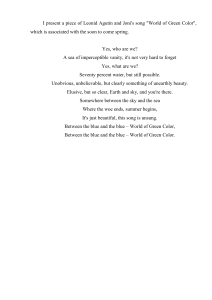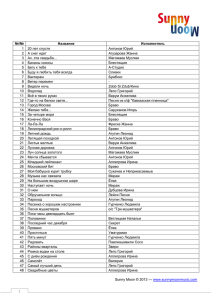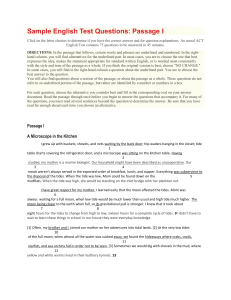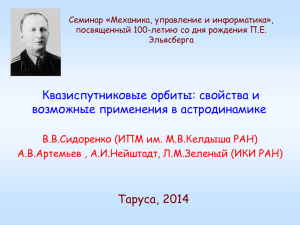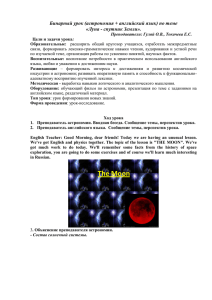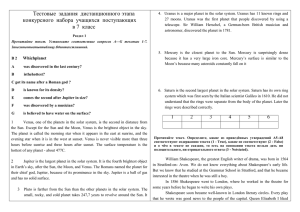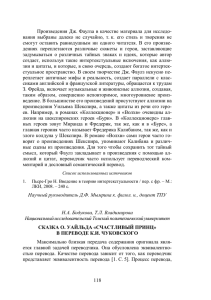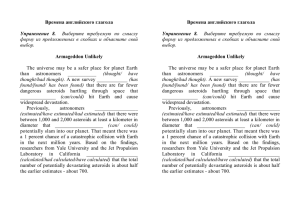t done
реклама
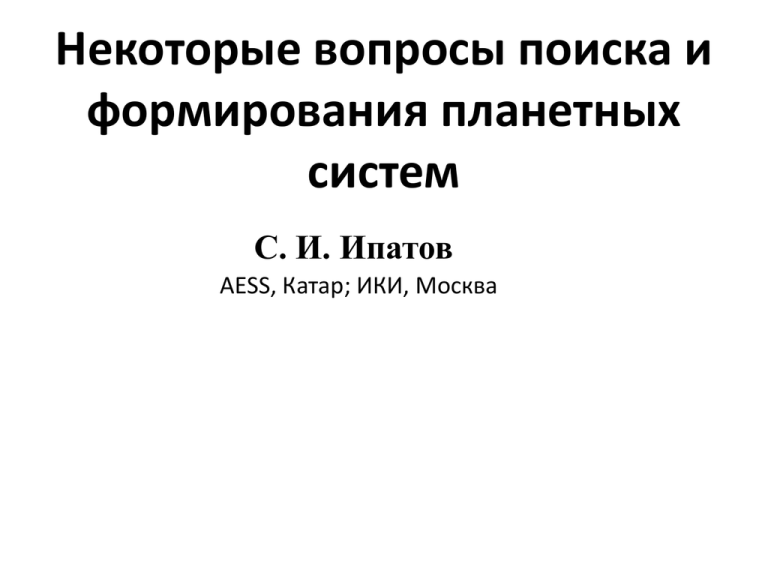
Некоторые вопросы поиска и формирования планетных систем С. И. Ипатов AESS, Катар; ИКИ, Москва SIMULATOR FOR MICROLENS PLANET SURVEYS Модель яркости звездного неба и алгоритм оптимального выбора целей для наблюдений при поиске экзопланет методом микролинзирования. С. И. Ипатов • На основе данных наблюдений, полученных в 2011 с помощью четырех телескопов, использующихся для поиска планет методом микролинзирования, построена модель яркости звездного неба. Эта модель является частью алгоритма оптимального выбора целей для наблюдений при поиске экзопланет методом микролинзирования. Алгоритм позволяет определять какие цели доступны для наблюдений в различное время и какие цели следует выбирать для того, чтобы максимизировать вероятность обнаружения экзопланет. An older version of a presentation on this item can be found on http://star-www.st-and.ac.uk/~si8/skybrightnessiau.ppt ---- Abstract We summarize the status of a computer simulator for microlens planet surveys. The simulator generates synthetic light curves of microlensing events observed with specified networks of telescopes over specified periods of time. The main purpose is to assess the impact on planet detection capabilities of different observing strategies, and different telescope resources, and to quantify the planet detection efficiency of our actual observing network, so that we can use the observations to constrain planet abundance distributions. At this stage we have developed models for sky brightness and seeing, calibrated by fitting to data from the OGLE survey and RoboNet observations in 2011. Time intervals during which events are observable are identified by accounting for positions of the Sun, the Moon and other restrictions on telescope pointing. Simulated observations are then generated for an algorithm that adjusts target priorities in real time with the aim of maximizing planet detection zone area summed over all the available events. 3 Studying planets by microlensing • • • • • • There is no single technique known that can yield the complete planet demographics. Microlensing is unique in its sensitivity to wider-orbit (i.e. cool) planetary-mass bodies 1) down to the mass of the Moon, already with groundbased observations, 2) in orbit around distant stars, even in neighbouring galaxies, 3) in orbit around faint or dark stars or remnants, such as brown dwarfs, white dwarfs, neutron stars, or black holes, 4) not bound at all. It thereby allows to explore a yet enigmatic region in mass separation space, where even a small amount of data has the potential to make a large impact. 4 If the source crosses a caustic, the deviations from a standard event can be large even for low mass planets. These deviations allow us to infer the existence and determine the mass and separation of the planet around the lens. Deviations typically last a few hours or a few days. Because the signal is strongest when the event itself is strongest, highmagnification events are the most promising candidates for detailed study. 2009 Gliese 581 e is an exoplanet with 1.9 Earth masses. Styding planets by microlensing The 15% blip lasting about 24 hrs that revealed 5-Earth-mass planet OGLE-2005-BLG390 impressively demonstrated the sensitivity of ongoing microlensing efforts to Super-Earths. Had an Earth-mass planet been in the same spot, it would have been detectable from a 3% signal lasting 12 hrs. The detection of less massive planets requires photometry at the few per cent level on Galactic bulge main-sequence stars, which, given the crowding levels, becomes possible with images of angular resolution below about 0.4″. 6 • Detection zone • Based on the approach presented in [3], at each time step for different events we calculate the detection zone area and the probability of detection of an exoplanet. The event with a maximum probability at a time step is chosen for observations. • We define the ‘detection zone’ (зона обнаружения) as the region on the lens plane (x,y) where the light curve (кривая блеска) anomaly δ(t,x,y,q) is large enough to be detected by the observations (q is the ratio of the planet to that of the star). [3] Horne K., Snodgrass C., Tsapras Y., MNRAS, 2009, v. 396, 2087-2102 Detection zones on the lens plane indicate the regions where a planet with mass ratio q=m/M=10-3 is detected with Δχ2>25. The light curve A(t) has maximum magnification Ao=5, and the accuracy of the measurements is σ=(5/A1/2) per cent. 7 Maximising planet detection zone area The photometric S/N (signal to noise) ratio and hence the area w of an isolated planet detection zone scales as the square root of the exposure time : S/N = (Δt /τ) 1/2 , w = g Δt 1/2 . Here τ is the exposure time required to reach S/N=1. The 'goodness' gi of an available target depends on the target's brightness and magnification, the telescope and detector characteristics, and observing conditions (airmass, sky brightness, seeing). The simulator evaluates 'goodness' of available targets in real time, and observes the one offering the greatest increase in w with exposure time. Moves to a new target occur when the increase in w for the new target is better than the current target, accounting for the slew time required to move to the new target. As the CCD camera takes a finite time tread to read out, and the telescope takes a finite time tslew to slew from one target and settle into position on the next, the ontarget exposure time accumulated during an observation time t is Δt=t- tslew –n tread (tslew ~ 1-3 min, tread ~10-20 s). At a time step Δt the detection area of i-th event increases by gi[(Δt+tdone) 1/2 - tdone1/2 ], where tdone is an exposure time already has been done. For a new target, the area is gi (Δt-tslew) 1/2 . See [3] for details. [3] Horne K., Snodgrass C., Tsapras Y., MNRAS, 2009, v. 396, 2087-2102. 8 Example of comparison of gi[(Δt+tdone) 1/2 - tdone1/2 ] for a choice of the best event to be observed (OGLE observations of 10 events: 110251 – 110260) at a time step of 200 s and tslew=100 s. All but one of the targets require slew time before the exposure can begin. 9 Target observability •The observability of a target is limited by its own position on the sky, as well as that of the Sun and the Moon, and telescopes moreover have pointing restrictions. Taking the LT (from http://telescope.livjm.ac.uk/) as example, we particularly require not to make observations at: •Air mass (≈1/cos[zenith angle of a target; зенитное расстояние]) > 3 or Cos (zenith of the Sun) < sin (-8.8o) or •Altitude of a target (высота цели): alt<altmin=25o or alt>altmax=87o or Hour angle: ha<hamin or ha>hamax. For LT there are no limits on ha: hamin=-12 h and hamax=12 h. • Telescopes considered: •1.3m OGLE - The Optical Gravitational Lensing Experiment - Las Campanas, Chile. • 2m FTS - Faulkes Telescope South - Siding Springs, Australia. • 2m FTN - Faulkes Telescope North - Haleakela, Hawaii. • 2m LT - Liverpool Telescope - La Palma, Canary Islands. • 10 •Observations analyzed for construction of sky model: •For studies of sky brightness for FTS, FTN, and LT, we considered those events observed in 2011 for which .dat files are greater than 1 kbt: FTS - 39 events; FTN - 19 events, LT – 20 events. For OGLE we considered 20 events (110251-110270). The observations were infrared. The used sky model was based mainly on K. Krisciunas & B. Schaefer, 1991, PASP, v. 103, 1033-1039. •Calculations of vskyzen (яркости звездного неба в зените) and the coefficients (k1 and ko) presented in the tables and on the plots were based on χ2 optimization of the straight line fit (y=k1·x+ko, χ2=∑[(yi-k1·xi-ko)/σi]2, σi2 is variance - дисперсия). The value of vskyzen (sky brightness at zenith) was chosen in such a way that the sum of squares of differences between observational and model sky brightness magnitudes (разности между наблюдаемыми и модельными звездными величинами яркости неба) were minimum in the case when the Moon is below the horizon. 12 Dependences of seeing on air mass and values of sky brightness at zenith obtained based on analysis of observations Values of sky brightness at zenith (I magnitude per square arcsec) for an extinction coefficient extmag=0.05 (for extmag equal to 0 and 0.1, values of vskyzen differed by less than 0.3 %): Telescope FTS FTN LT OGLE vskyzen 20.07 19.87 20.74 19.99 Seeing (FWHM in arcsec) vs airmass (χ2 optimization): seeing=ko+k1×(airmass-1). Seeing is the blurring effects of air turbulence in the atmosphere (угловой диаметр кружка, в виде которого изображение звезды предстает в телескопе; эффект расплывчатости изображения из-за турбулентности в атмосфере). σ– среднеквадратичное отклонение Telescope ko k1 σ - sigma FTS 1.33 0.52 0.37 FTN 0.68 0.21 0.21 LT 1.35 0.42 0.50 OGLE 1.33 0.29 0.25 13 Seeing vs. air mass. Seeing (in arcsec) vs. air mass. FTS observations of 39 events. A thick straight line is based on χ2 optimization (y=a+b(x-1), a=1.334, b=0.519). Thinner straight lines differ from this line by +/- Ϭ (Ϭ=0.367). Non-straight lines show mean and median values (the line for the mean value is thicker). 14 ) Sky brightness (mag) (звездная величина яркости неба) vs. air mass. Different points are for OGLE observations of 20 different events (110251 – 110270) for the Moon below the horizon and solar elevation < -18o. The lines are for the χ2 optimisation with different ko (different values for different events) and the same k1. The most solid line is for the model for which ko is the same for all events. 15 The difference in sky brightness near different events. Coefficients for sky brightness=bo+b1×(airmass-1). One value of b1; values of bo are different for different events. The range of boi for Moon below the horizon and solar elevation < -18o: • min max max-min telescope •19.49 20.41 0.92 FTS •19.05 20.15 1.10 FTN •19.89 20.60 0.71 LT •19.64 20.35 0.70 OGLE The values of max-min were about 0.7-1.1 mag. The difference max-min characterizes the difference in sky brightness due to surrounding stars near different events. The range of boi for FTS for different positions of the Moon and the Sun: min max max-min data considered • 18.2 20.2 2.0 - all observations • 19.3 20.4 1.1 - moon below the horizon • 19.5 20.4 0.9 - moon below and solar elevation < -18o The upper limit (less bright observations) in the above table does not vary much; the difference in the lower limit (more bright sky) is greater and is up to 1.5 mag. When the Moon is below the horizon and solar elevation <-18o , then σ is smaller than that for all observations by a factor of 3 (0.11 instead of 0.36). The data of the table show the influence of positions of the Moon and the Sun on a typical sky brightness near an event. 16 Residuals of sky brightness Most of residuals (разности) (observations minus χ2 optimization which is different for different events) of sky brightness are in a small range (-0.4 to 0.4 mag) even for all Moon and Sun positions; for the Moon below the horizon there are many of values in the range [-0.2, 0.2]; greater values of residuals are for a small number of observations. The range of sky brightness residuals for the Moon below the horizon and solar elevation <-18o (for example, [-0.42, 0.87] for FTS) is smaller by a factor of several than for all positions of the Moon and Sun. For considered observations, there was no bright sky (i.e. the lower limit of residuals was >-1 mag) only in the case when both the Moon was below the horizon and the solar altitude was <-18o. 17 Sky brightness residuals (mag) vs. air mass for the model with different ko for FTS observations of 39 events. Left plot is for all positions of the Moon and the Sun. Right plot is for the Moon below the horizon and solar elevation < - 18o. 18 Sky brightness residuals vs. solar elevation Analysis of the plots shows that the influence of solar elevation (высоты солнца) on sky brightness began to play a role at solar elevation > -14o, and was considerable at solar elevation >-7o. For example, if we consider only observations with the Moon below the horizon, then for FTS: sbr >-0.4 mag at se<-14o, sbr>-1 at se<-8o, sbr can be up to -3 mag at se in the range (-8o,-7o), where se is the value of solar elevation, and sbr is the value of sky brightness residual (in mag). Sky brightness residuals (in mag.) vs. solar elevation for FTS observations of 39 events. More dense signs are for the Moon below the horizon. 19 Time intervals when it is better observe events Time intervals for events selected for observations with OGLE. Considered events: 110250110400 (numbered from 1 to 151). 0 event corresponds to ‘no observations’. Initial Julian time=2455728.5 (June 15, 2011). 20 Light curves Light curves for events selected for observations with OGLE. Considered events: 110250-110400. Initial Julian time=2455728.5 (June 15, 2011). 21 CONCLUSIONS At this stage we have developed models for sky brightness and seeing, calibrated by fitting to data from the OGLE survey and RoboNet observations in 2011. Time intervals during which events are observable are identified by accounting for positions of the Sun, the Moon and other restrictions on telescope pointing. Simulated observations are then generated for an algorithm that adjusts target priorities in real time with the aim of maximising planet detection zone area summed over all the available events. • • • • • REFERENCES [1] M. Dominik, 2010, Gen. Relat. Gravit. 42, 2075 [2] Y. Tsapras, R. Street, K. Horne, et al., 2009, AN 330, 4 [3] K. Horne, C. Snodgrass, Y. Tsapras, 2009, MNRAS 396, 2087 [4] K. Krisciunas & B. Schaefer,1991, PASP, 103, 1033 22
